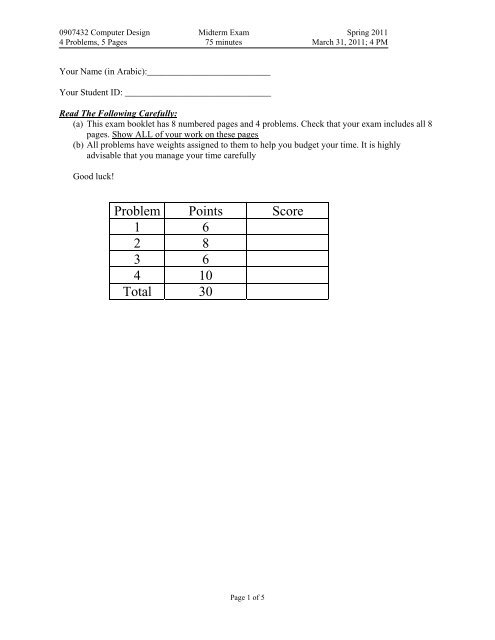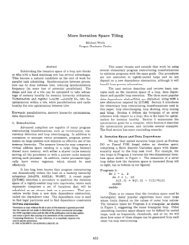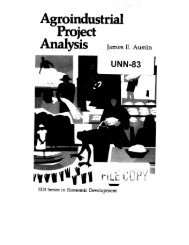Midterm Solution
Midterm Solution
Midterm Solution
Create successful ePaper yourself
Turn your PDF publications into a flip-book with our unique Google optimized e-Paper software.
0907432 Computer Design <strong>Midterm</strong> Exam Spring 2011<br />
4 Problems, 5 Pages 75 minutes March 31, 2011; 4 PM<br />
Your Name (in Arabic):___________________________<br />
Your Student ID: ________________________________<br />
Read The Following Carefully:<br />
(a) This exam booklet has 8 numbered pages and 4 problems. Check that your exam includes all 8<br />
pages. Show ALL of your work on these pages<br />
(b) All problems have weights assigned to them to help you budget your time. It is highly<br />
advisable that you manage your time carefully<br />
Good luck!<br />
Problem Points Score<br />
1 6<br />
2 8<br />
3 6<br />
4 10<br />
Total 30<br />
Page 1 of 5
0907432 Computer Design <strong>Midterm</strong> Exam Spring 2011<br />
4 Problems, 5 Pages 75 minutes March 31, 2011; 4 PM<br />
Problem 1 Amdahl’s Law (6 points)<br />
Three enhancements with the following speedups are proposed for a new architecture:<br />
Speedup1 = 30<br />
Speedup2 = 20<br />
Speedup3 = 15<br />
Only one enhancement is usable at a time.<br />
If enhancements 1 and 2 are each usable for 25% of the time, what fraction of the time must<br />
enhancement 3 be used to achieve an overall speedup of 10<br />
Page 2 of 5
0907432 Computer Design <strong>Midterm</strong> Exam Spring 2011<br />
4 Problems, 5 Pages 75 minutes March 31, 2011; 4 PM<br />
Problem 2 Loop unrolling [8 points]<br />
Unroll the following loop twice and schedule it, then find how many cycles are needed to execute one<br />
iteration of the unrolled loop. Assume that you have the five-stage pipeline with multi-cycle<br />
operations, FP operations takes 2 cycles, branch instructions are resolved in the Decode stage, and the<br />
processor can write one integer result and one FP result in the Write Back stage every cycle.<br />
The number of cycles needed is: ___15____<br />
Loop: l.d F0, 0(R1) F D E M W<br />
l.d F4, 0(R2) F D E M W<br />
mul.d F0, F0, F4 F D – E E M W<br />
add.d F2, F2, F0 F – D – E E M W<br />
daddui R1, R1, #-8 F – D E M W<br />
daddui R2, R2, #-8 F D E M W<br />
bnez R1, Loop F D E M W<br />
1 2 3 4 5 6 7 8 9 0 1 2 3 4 5<br />
Loop: l.d F0, 0(R1) F D E M W<br />
l.d F4, 0(R2) F D E M W<br />
l.d F6, -8(R1) F D E M W<br />
mul.d F0, F0, F4 F D E E M W<br />
l.d F8, -8(R2) F D E M W<br />
add.d F2, F2, F0 F D E E M W<br />
mul.d F6, F6, F8 F D E E M W<br />
daddui R1, R1, #-16 F D E M W<br />
add.d F2, F2, F6 F D E E M W<br />
daddui R2, R2, #-16 F D E M W<br />
bnez R1, Loop F D E M W<br />
Page 3 of 5
0907432 Computer Design <strong>Midterm</strong> Exam Spring 2011<br />
4 Problems, 5 Pages 75 minutes March 31, 2011; 4 PM<br />
Problem 3 Branch Prediction [6 points]<br />
Consider the following piece of code:<br />
DADDI R1, R0, #100<br />
L1: DADDI R1, R1, #-1<br />
BEQZ R1, END -- Branch 1<br />
DADDI R12, R0, #2<br />
L2: DADDI R12, R12, #-1<br />
BNEZ R12, L2 -- Branch 2<br />
J<br />
L1<br />
END: ...<br />
Assume R0 stores 0. Branch 1 is executed 100 times and branch 2 is executed a total of 198 times.<br />
For each branch, how many correct predictions will occur if we use the following prediction schemes<br />
Assume at the beginning of execution, the last branch was not taken. Please explain your answers.<br />
Part A [3 points]: 1-bit predictor initialized to T (taken)<br />
<strong>Solution</strong> :<br />
Branch 1, N,N,N,…,N,T is predicted correctly every time except the first and last.<br />
Branch 2 alternates T,N,T,N,.. and thus is predicted incorrectly every time except the first.<br />
Branch 1 : 98 correct, Branch 2 : 1 correct prediction<br />
Grading : ½ point for each number and 1 point for each explanation.<br />
Part B [3 points]: 2-bit saturating predictor initialized to 10 (taken)<br />
<strong>Solution</strong> :<br />
Branch 1 is predicted correctly every time except the first and last.<br />
Branch 2’s predictor alternates between 10 and 11, and thus predicts correctly every other<br />
time.<br />
Branch 1 : 98 and Branch 2 : 99 correct predictions<br />
Grading : ½ point for each number and 1 point for each explanation.<br />
Problem 4 Tomasulo’s algorithm [10 points]<br />
Page 4 of 5
0907432 Computer Design <strong>Midterm</strong> Exam Spring 2011<br />
4 Problems, 5 Pages 75 minutes March 31, 2011; 4 PM<br />
This problem concerns Tomasulo’s algorithm. Consider the following architecture specifications:<br />
Functional Unit Type Cycles in EX Number of Functional Units<br />
Integer 1 1<br />
FP Adder 2 1<br />
FP Multiplier 10 1<br />
1) Assume that you have unlimited reservation stations.<br />
2) Memory accesses use the integer functional unit to perform effective address calculation during the<br />
EX stage. For stores, memory is accessed during the EX stage. All loads access memory during the<br />
EX stage. Loads and Stores stay in EX for 1 cycle.<br />
3) Functional units are not pipelined.<br />
4) If an instruction moves to its WB stage in cycle x, then an instruction that is waiting on the same<br />
functional unit (due to a structural hazard) can start executing in cycle x.<br />
5) An instruction waiting for data on the CDB can move to its EX stage in the cycle after the CDB<br />
broadcast.<br />
6) Only one instruction can write to the CDB in a cycle. Stores do not need the CDB.<br />
7) Whenever there is a conflict for a functional unit or the CDB, assume that the oldest (by program<br />
order) of the conflicting instructions gets access, while others are stalled.<br />
8) Assume that the result from the integer functional unit is also broadcast on the CDB and forwarded<br />
to dependent instructions through the CDB (just like any floating point instruction).<br />
Complete the following table using Tomasulo’s algorithm. Only one instruction could be issued in a<br />
clock cycle. Fill in the cycle numbers in each pipeline stage. The entries for the first instruction are<br />
filled in for you. Explain the reason for any stalls.<br />
# Instruction IS EX WB Reason for Stalls<br />
1 L.D F0, 0(R1) 1 2 3<br />
2 L.D F2, 8(R1) 2 3 4<br />
3 MUL.D F4, F0, F2 3 5-14 15 Data dependence F2 (from 2)<br />
4 S.D F4, 24(R1) 4 16 -- Data dependence F4 (from 3)<br />
5 L.D F0, 16(R1) 5 6 7<br />
6 ADD.D F4, F0, F6 6 8-9 10 Data dependence F0 (from 5)<br />
7 ADD.D F2, F4, F8 7 11-12 13 Data dependence F4 (from 6)<br />
8 MUL.D F4, F4, F10 8 15-24 25 MUL FU occupied (from 3)<br />
9 S.D F2, 32(R1) 9 14 -- Data dependence F2 (from 7)<br />
10 S.D F4, 40(R1) 10 26 -- Data dependence F4 (from 8)<br />
11 DADDI R1, R1, #40 11 12 14 CDB Occupied<br />
Grading:<br />
-1 for each missed dependency (data or structural). –1 for any other errors. Cascading errors should not<br />
be penalized additionally as long as the relevant dependencies are still observed.<br />
Page 5 of 5














![Problem 1: Loop Unrolling [18 points] In this problem, we will use the ...](https://img.yumpu.com/36629594/1/184x260/problem-1-loop-unrolling-18-points-in-this-problem-we-will-use-the-.jpg?quality=85)


